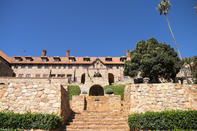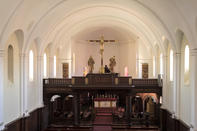James Nash Retires and Returns
The role of the Community of the Resurrection in the running of St John's College continued for two decades after the retirement of James Nash in 1917.

Father Clement Thomson, Nash's long-time colleague, took over as headmaster until the end of 1920, when he returned to England. He was succeeded by Father Edward Symonds, a teacher with a brilliant academic record, having gained a triple first at Queen's College, Oxford. However, ill health forced Symonds to resign in October 1921 and return to England.
James Nash filled in as temporary head for the first term of 1922, pending the appointment of a headmaster. The man given the task was Eustace Hill. Very different in style from Nash, not a great scholar and no longer robust, Hill nevertheless proved to be an able successor.
Eustace Hill
He was a much-loved headmaster, the second legendary head of St John’s. He soon realised that the school would have to expand and so, despite a country-wide recession, he determinedly set about with the building of what is today the senior college.
Hill was a most effective and successful headmaster. During his term of office the building progress that had been so spectacular under Nash proceeded apace - indeed, by the time Hill left the school, the fabric of the college was very much as it remained until 1960. Enrolment was up to 480, with 300 in the college. Academically and on the sports field the reputation of the school stood firm among the best.
Father Charles Runge

Father Charles Runge succeeded Hill as the fifth and last of the Fathers of the Community to serve as head of St John’s. Like Hill, Runge had a notable war record, having won the Distinguished Service Order and Military Cross and Bar. He was also a gifted scholar and a man of great culture.
When Runge took over as headmaster, St John’s was well established and successful, both in and out of the classroom - but he added the final polish. Important innovations introduced by
Runge included an improved level of administration; the introduction of a post-matric year; and, following the trend of schools throughout the Transvaal, the replacing of soccer by rugby. Additionally, the appointment in 1931 of Mr Noel Iverson as resident choir master proved extremely significant in the cultural life of the school - Iverson moulded the choir into a unit that won renown, making musical productions a popular and regular institution of the school and selling to the boys the idea that a place in the choir carried real status.
Although the school already had a completed look when Charles Runge took over, a considerable amount of additional building was carried out during his relatively short term of office, but this was to be the last significant building work for 20 years. The additions not only provided badly needed accommodation for the 500 pupils and staff at the school in 1934, but served to link together the complex as a unified whole. With St John's College well and truly established, and so much other pressing work to concentrate on, this was perhaps a most fitting time for Runge and the Community to bow out.